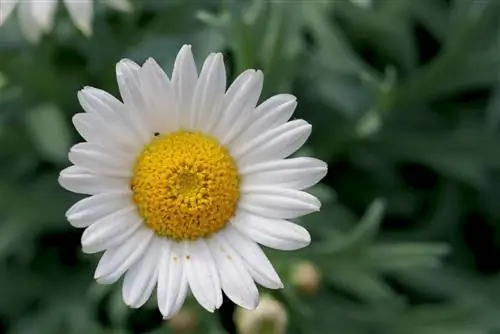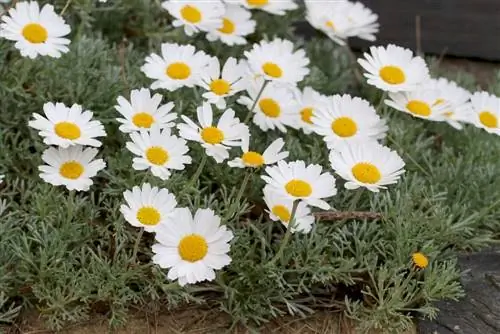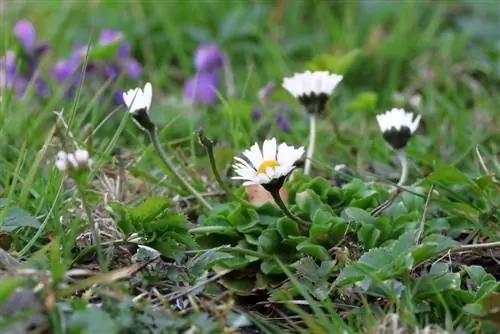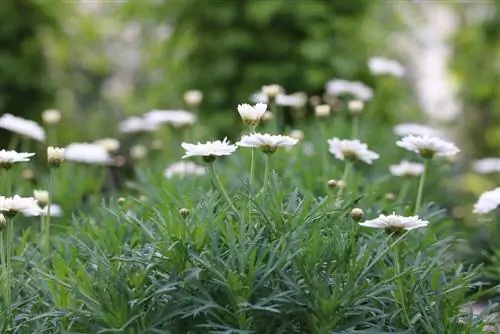- Author admin [email protected].
- Public 2023-12-17 03:39.
- Last modified 2025-01-24 12:45.
The care required for the daisy is very low, so it can be described as easy to care for. The daisy's flowering period begins in spring and lasts until the first frost. The flowers are characterized by their radial shape, which looks like a large variety of daisies. However, the petals can also be yellow or pink and have a yellow or dark center. Some varieties of daisy are even filled. The daisy leaves foliage all year round and the foliage is very dark green and shiny. The plant's growth is bushy and the plant can reach a height of between 30 cm and 150 cm.
Care for daisies in the garden and as a container plant
The daisy, which is cultivated for the garden, has a slightly different growth habit than the meadow daisy. However, like the meadow daisy, it also has a long and slightly angular stem that forms small runners and on which both the jagged leaves and the inflorescences are present. The flowers have a diameter of between 4 and 6 cm, although the cultivated daisy is smaller than the meadow daisy. What is interesting is that the individual flowers emit an intense smell from the center, which attracts insects. These play an important role in the reproduction of the plant, although it also forms runners in addition to the aerial sprouts. The daisy is planted in normal potting soil without adding any further fertilizer. The daisy responds well to this simple potting soil. By the way, it doesn't like soil that is too wet at all.
Daisy plants in pots need to be repotted regularly so that their space requirements can be met. If you don't want excessive growth, you should dig up the plant, divide it and bury the divided plant area again elsewhere. The plant blooms from May to October. In more severe weather conditions, the plant's flowering also stops before October when the environment becomes relatively humid. Under no circumstances should the daisy be transplanted during the flowering period.
In summary, daisies like:
- normal potting soil without fertilizer
- moderate humidity
- regular repotting
- absolutely no transplanting during the flowering phase
Cutting daisies?
In principle, it is not necessary to prune the daisy. However, if the growth of the plant no longer meets your expectations because leaves protrude and lateral branches of the stems appear, the plant can also be trimmed so that it does not grow too wide. If you want to prune the plant, you should plan the pruning well outside the flowering period so that the flowers and buds are not damaged and can develop optimally. If you don't want any further propagation, the branches of the daisy can also be trimmed. This can be very useful because the plant reproduces very quickly, which is quite straightforward for it.
Location for daisies
The daisy can thrive on many surfaces because it is relatively undemanding. Even subsoils that are not very rich in nutrients and even alpine high- altitude regions generally do not pose a problem for the daisy. Even if the daisy can generally tolerate frost, it should be spared if possible. As a potted plant, it only needs simple potting soil and a sunny location.
Overwinter daisy properly
The best way to overwinter the daisy is to move it indoors over the winter. However, this option is only theoretical, because the effort involved in wintering is disproportionate to the success. It is better to simply buy the annual and inexpensive plants in our regions again next year, especially since they will then be much more lush and beautiful than a plant that has been overwintered. If you want to put the daisy in the garden, on the terrace or on the balcony next year, then it should be protected from frost, because it doesn't tolerate it well and becomes sparse. For overwintering, you should not keep the plant too cool, stop fertilizing it and only water it sparingly over the winter.

It is absolutely important to cut back the plant if it is to be overwintered. In summer, it makes sense to prune lightly so that wilted inflorescences are regularly removed. This distance stimulates the plant to form new buds.
Propagation of the daisy
The propagation of the daisy is very easy and can be done by sowing. The planting time is in spring and sowing can easily be done with seeds that can be found at specialist retailers at the appropriate time.
Pests and diseases of daisies
As resistant and robust as the plant is, it also shows its best side when it comes to disease and pest infestation. Occasionally the plant may be attacked by caterpillars if it is left outdoors. Combating this infestation is very easy, as it is sufficient to collect the caterpillars. When kept as a houseplant, the plant is even spared from these uncomplicated pests. It can be problematic if the plant is watered too much. In this case, it can react with both mold formation and fungal infestation. However, this can be prevented by moderate and regular watering.
The daisy is robust, but can occasionally be attacked by caterpillars and react to excessive watering with mold and fungal infestation.
What you should know about the daisy in brief
- The daisy is a robust and undemanding plant that is an annual and is not worth overwintering.
- Daisies as perennial herbaceous plants have a height of 30 to 60 cm.
- The stem has a slightly angular shape, it is upright and partially branched.
- The lower leaves on the stem in particular are very coarsely toothed, while the upper ones are finer.
- The entire flower has a diameter of 4 and 6 cm. Inside the flower there are yellow tubular flowers, on the outside there are white bracts.
- The inner part of the flower has a very strong smell, which is intended to attract insects, which are partly responsible for the reproduction of this plant.
- The daisy also takes on part of its reproduction by forming runners.
- The plant primarily prefers open meadows and pioneer soils, but it still thrives even at alpine altitudes.
- The daisy forms both runners and aerial shoots and can therefore spread very quickly in its area.
- This is one of the reasons why it is usually seen in large quantities in one spot.
- The flowering period of the daisy extends from May to October.
- But it does not require any special care as it is a very undemanding plant.
Cutting the daisy is absolutely unnecessary and would have no effect, only digging up individual plants if the population is too dense can be a way to beautify the overall picture. Of course, it has to absorb moisture regularly, but the daisy tolerates soil that is too moist very poorly, which is why you shouldn't water it too often if you want to admire it in your home garden.
bush daisies
A particularly popular form of daisy in home gardens is the bush daisy, which is planted in pots and is a special growth form of the daisy family. You can plant the daisy from spring to autumn, although it has so far proven to be a good idea not to plant it during the flowering period. If a bush daisy grows too large, it should be placed in a suitable larger pot after the flowering period so that it does not break.






